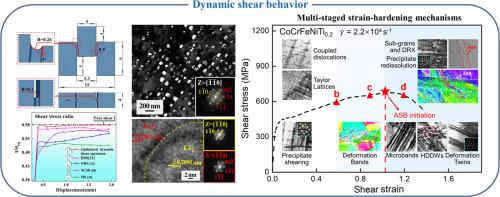纳米沉淀物对高熵合金绝热剪切带形成的影响
IF 14.3
1区 材料科学
Q1 MATERIALS SCIENCE, MULTIDISCIPLINARY
引用次数: 0
摘要
绝热剪切带是材料在动载荷作用下发生突变破坏的重要前兆,受材料微观结构特性的影响很大。在这项工作中,首先开发了一种优化的试件类型,使整个变形过程中剪切区域的应力状态更接近纯剪切状态。为了阐明纳米沉淀对绝热剪切带形成的影响,采用分离式霍普金森压杆和优化试样类型测试了两种L12纳米沉淀强化高熵合金在不同温度(77、293和873 K)下的动态剪切行为,并借助中断实验表征了相应的显微组织演变。分散在面心立方基体中的纳米沉淀物对高熵合金的动态剪切行为有显著而有趣的影响。相对较大尺寸和适当体积分数的L12纳米沉淀物的微妙结合促进了多种应变硬化机制,并抵抗热软化,从而导致对绝热剪切带的优异抵抗。在高密度位错、绝热温升和高剪切应力的协同作用下,L12纳米沉淀在剪切区瞬时再溶后,立即形成动态再结晶诱导的绝热剪切带。最后,给出了两种L12纳米沉淀强化高熵合金在不同温度下的变形机理图。该系统的研究有望为设计在大温度范围内具有优异绝热剪切性能的纳米沉淀强化高熵合金开辟一条新的途径。本文章由计算机程序翻译,如有差异,请以英文原文为准。

Effect of nanoprecipitates on the formation of adiabatic shear band in high-entropy alloy
The adiabatic shear band is a crucial precursor of catastrophic failure for materials subjected to dynamic loading, deeply influenced by the microstructural characteristics. In this work, an optimized specimen type was first developed to make the stress state in the shear region closer to pure shear during the entire deformation. To elucidate the effect of nanoprecipitates on the formation of adiabatic shear band, dynamic shear behaviors of two L12 nanoprecipitate-strengthened high-entropy alloys at different temperatures (77, 293, and 873 K) were tested using a split Hopkinson pressure bar and the optimized specimen type, and the corresponding microstructure evolutions were characterized with the aid of interrupt experiments. The nanoprecipitates dispersed in a face-centered cubic matrix exhibit a significant and intriguing effect on the dynamic shear behavior of the high-entropy alloys. The subtle combination of relatively large size and advisable volume fraction of L12 nanoprecipitates promotes multiple strain hardening mechanisms and resists thermal softening, leading to the exceptional resistance to adiabatic shear band. Immediately after the instantaneous redissolution of L12 nanoprecipitates in the shear region due to the synergetic effect of high-density dislocations, adiabatic temperature rise, and high shear stress, the adiabatic shear bands induced by dynamic recrystallization form. Finally, a deformation mechanism map for the two L12 nanoprecipitate-strengthened high-entropy alloys is proposed at different temperatures. The systematic study looks forward to opening a potentially new avenue for the design of nanoprecipitate-strengthened high-entropy alloys with superior adiabatic shear resistance over a wide range of temperatures.
求助全文
通过发布文献求助,成功后即可免费获取论文全文。
去求助
来源期刊

Journal of Materials Science & Technology
工程技术-材料科学:综合
CiteScore
20.00
自引率
11.00%
发文量
995
审稿时长
13 days
期刊介绍:
Journal of Materials Science & Technology strives to promote global collaboration in the field of materials science and technology. It primarily publishes original research papers, invited review articles, letters, research notes, and summaries of scientific achievements. The journal covers a wide range of materials science and technology topics, including metallic materials, inorganic nonmetallic materials, and composite materials.
 求助内容:
求助内容: 应助结果提醒方式:
应助结果提醒方式:


